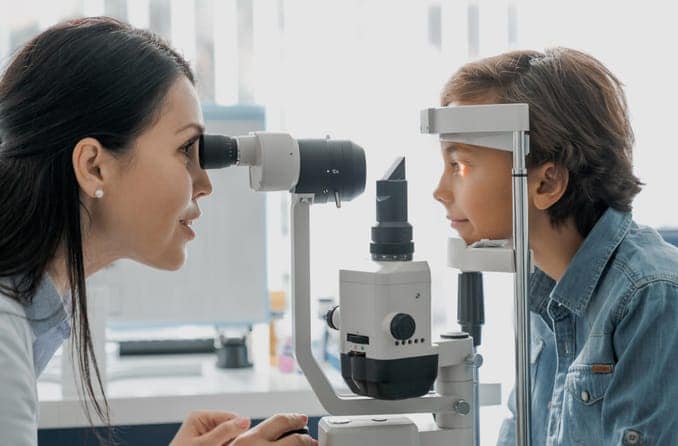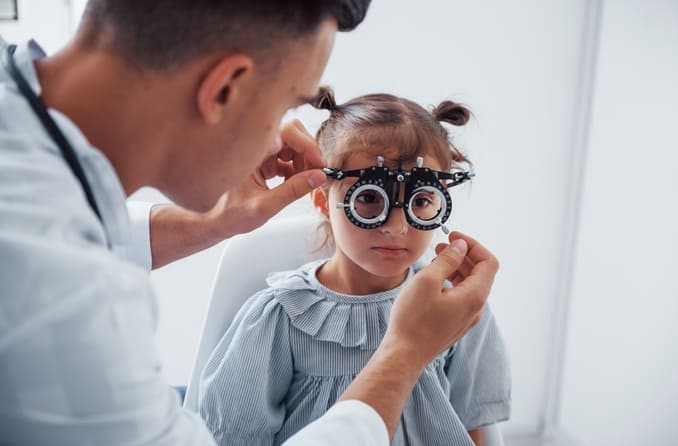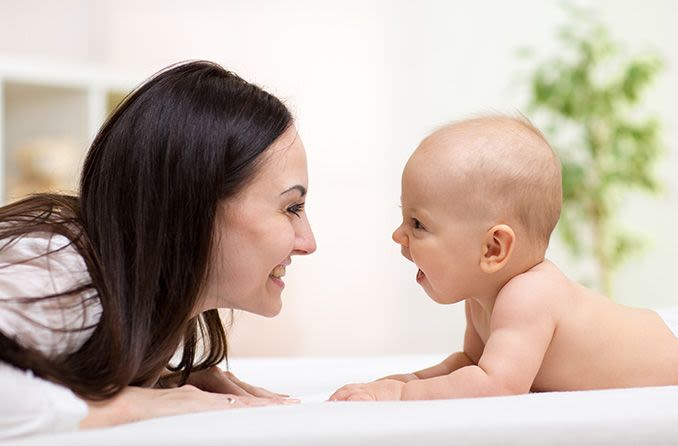The journey of baby vision development
Good sight is essential for your child to explore their world, reach for toys, play and eventually learn skills like reading and writing. Just like learning to crawl and walk, clear vision is a skill that babies develop over time.
Infants aren't born with all the visual abilities they'll need. Their sensory development progresses with each passing month. The first few years are a critical period for vision. Without proper visual development during this time, the ability to process sight correctly can be affected, sometimes permanently. Early detection of eye and vision problems in babies can prevent lifelong vision issues.
If your baby arrived early, base their milestones on their original due date rather than their actual birth date. This will provide a more accurate picture of their development.
Key milestones in infant vision
Your baby’s eyes work like little video cameras. They collect information about the world around them and send that information to the brain. The brain then learns how to make sense of these signals.
It takes time and practice for a baby to develop skills like focusing their gaze. They also need to learn how to move their eyes accurately and use both eyes together effectively. This is all part of how they begin to understand their environment.
Infant visual development occurs rapidly in the first few months. While the milestones below are helpful guidelines, remember that every child is different. It's normal for some babies to reach these goals a bit earlier or later than others.
Birth to 1 month: Seeing for the first time
At birth, your newborn's world is quite blurry. Infant vision development starts with vision estimated at 20/200 to 20/400. For context, 20/200 is the big E on most eye charts. They can see movement and detect shapes and light. It's important to remember that it takes time for babies to coordinate their eye movements.
In the early weeks, you may notice that a newborn's eyes occasionally drift, cross or move in different directions. This is completely normal and is part of their development. By around 2 to 3 months old, these random movements should start to decrease as their vision improves.
Newborns are sensitive to light and have small pupils, which will gradually widen after a few weeks. The light-sensitive tissue at the back of the eye, called the retina, will also continue to develop.
Baby’s vision and milestones from birth to 1 month include:
- Cuddling distance – Your baby sees best at a distance of 8 to 12 inches (20 to 30 cm) from their face — perfect for gazing at you during feeding.
- High-contrast patterns – Newborns can’t see well yet, so provide them with high-contrast patterns, like black and white shapes or stripes.
- First connections – Engage your baby as they begin to watch you and follow moving objects.
2 to 4 months: Building focus and tracking
It can take time for babies to learn how to use both their eyes together. If one eye constantly turns in or out after two months, let your pediatrician know.
Baby’s vision and milestones from 2 to 4 months include:
- Focusing and tracking – Your baby should start following moving objects with their eyes.
- Eye-hand coordination – Your baby may begin reaching for objects or watching their moving hands.
- Single image – Your baby begins to merge images from both eyes into one clear picture.
5 to 8 months: Developing depth perception and color vision
By month five, your baby's eyes should work together consistently and appear straight. If you notice a constant eye turn after this age, it's important to get it checked.
Baby’s vision and milestones from 5 to 8 months include:
- Seeing in 3D – Depth perception (the ability to judge how far away something is) starts developing around 5 months. This happens as the eyes learn to work together. This is called binocular vision.
- Full color – By 5 to 6 months of age, your baby sees colors much like you do.
- Crawling and seeing – Crawling and creeping help build coordination between the eyes, hands and feet.
9 to 12 months: Strengthening coordination and recognition
As your baby starts moving more, they gain better control over their eyes and body. This movement helps them refine their visual skills.
Baby’s vision and milestones from 9 to 12 months include:
- Recognition – By 8 to 10 months, your baby should recognize familiar faces.
- Seeing small objects – They can spot tiny objects (such as a Cheerio) and try to reach for them.
- Pointing and seeking – By 12 months, they can point at pictures in books and look for items placed in a bin.
1 to 2 years: Fine-tuning visual skills
Between their first and second birthdays, your toddler's vision sharpens rapidly. By age 2, eye-hand coordination and depth perception should be well-developed.
Baby’s vision and milestones from 1 to 2 years include:
- Picture recognition – Recognizing familiar objects and graphics in books.
- Scribbling – Using crayons or pencils to draw, using better hand‑eye coordination to do so.
- Matching shapes – Placing shapes into the right spots.
- Pointing and using gestures – Asking for things or drawing your attention to what they see.
- Recognizing their own face – Looking in the mirror and recognizing themselves.
- Shifting focus between near and far objects – Looking from a toy in their hand to something across the room.
- Pointing to body parts – Touching their nose, head or eyes when you name them.
Signs of vision problems in infants
Detecting eye problems early is crucial because treatment works best when started young. Untreated issues can lead to permanent vision loss, so it's better to check with your doctor if you're concerned.
White or grayish-white color in the pupil
If the dark circle in the center of the eye (the pupil) looks white or cloudy instead of black, this may signal a problem. Examine photographs of your baby to make sure the red reflection appears the same in both eyes. If the reflections differ between eyes, share this with your child’s doctor.
Eye alignment problems (strabismus)
Strabismus is a condition in which the eyes do not align or move together properly. One eye may turn inward, outward, upward or downward. By the age of 3 to 4 months, your baby’s eyes should be aligned. If you notice this in your child after 4 months of age, it is important to have your child’s eyes examined.
This condition:
- Develops by age 3.
- Affects about 4% of the population.
- Runs in families.
Many parents hope their child will outgrow crossed eyes. But waiting to get it checked can cause long-term vision issues. When eyes point in different directions, the brain receives two separate images.
To prevent double vision, the brain may ignore signals from the misaligned eye, leading to amblyopia (lazy eye) and poor vision development in that eye. Early treatment is critical.
Lazy eye (amblyopia)
Amblyopia develops when one eye sees more clearly than the other. Over time, the brain strengthens visual pathways for the stronger eye while neglecting the weaker one. This can happen even if the weaker eye is healthy. Because the brain never learns to properly interpret signals from the weaker eye, vision remains poor in that eye.
This condition typically develops in infancy or early childhood. It can get worse if left untreated. Amblyopia affects 1 in 20 children younger than 15 years. It can result from several causes, including:
- Uncorrected refractive errors (nearsightedness, farsightedness or astigmatism)
- Misaligned eyes (strabismus)
- Structural problems like cataracts or drooping eyelids that block clear vision
Amblyopia does not go away on its own and can lead to permanent vision loss without intervention. Treatment is most effective when begun early, and includes:
- Glasses or contact lenses
- Eye patching
- Medicated eye drops
Involuntary eye movements (nystagmus)
Nystagmus is a condition in which the eyes make rapid involuntary movements. This can be side to side, up and down, or in circles. Some children are born with it, while others develop it later due to problems affecting the brain, inner ear or visual system.
If you notice unusual eye movements or sudden changes in vision or balance, contact your child’s doctor. Nystagmus can sometimes signal a more serious underlying condition.
Symptoms of nystagmus include:
- Blurred or shaky vision
- Difficulty with depth perception
- Challenges with balance
Glasses or contact lenses may help manage symptoms and improve vision. Your child may also need a referral to a pediatric ophthalmologist for certain medications or surgery.
Supporting your baby's visual development
Everyday play can support your baby’s visual development. Newborns see best up close and are drawn to simple, high‑contrast patterns. So, placing bold toys or faces 8 to 12 inches from their eyes and changing their position in the crib helps them practice focusing and tracking.
Interactive play and toys
As babies grow, allow them to explore in a safe area. Activities that can help encourage visual development include:
- Looking at high-contrast toys
- Reaching for toys
- Playing peekaboo
- Watching you as you move around and talk to them
- Crawling in a secure play area
- Playing patty-cake
- Providing playdates
From around one year on, simple activities can provide stimulation for your baby’s brain and eyes. These include:
- Building with blocks
- Rolling or tossing balls
- Looking at picture books
- Scribbling and coloring
- Riding on wheeled toys
Throughout these stages, it’s important to prioritize real‑world play, limit long stretches of screen time and provide a healthy lifestyle that includes good sleep, outdoor time and balanced nutrition. All these things support strong, healthy visual development.
Regular eye checkups
As your baby grows, regular eye exams should become a part of their routine wellness care. For children at low risk of vision issues, the American Optometric Association recommends exams at 6 to 12 months of age or as recommended.
Infants born prematurely or those with a family history of eye problems should be seen by an optometrist or at a pediatric ophthalmology office sooner.
A typical eye examination for a baby includes:
- Patient history – The doctor will go over your child’s health, development, the pregnancy and birth history, and any family eye problems to identify risk factors for vision issues.
- Visual acuity – Instead of an eye chart, the doctor watches how your baby looks at and follows faces and/or objects at different distances to see how clearly they can see.
- Checking for refractive error – The doctor measures whether your baby is nearsighted, farsighted or has astigmatism.
- Eye movements – The doctor moves a light or toy and observes how smoothly and accurately your baby’s eyes follow, checking their eye muscles.
- Eye alignment and teamwork – By briefly covering and uncovering each eye, the doctor looks for eye turns and evaluates how well the two eyes work together.
- Eye health – The doctor examines the baby’s eyes for signs of disease.
- Assessment and communication – After the exam, the doctor explains the findings, recommends any follow-up and can send a summary to your child’s pediatrician to coordinate care.
Speak to your child’s doctor if you notice certain signs, symptoms or behaviors, such as:
- The pupil looks white or cloudy instead of black.
- Their eyes do not align or move together properly.
- Their eyes make rapid involuntary movements.
- They show little interest in things that are far away.
- They hold books, screens or toys very close to their face.
- They squint or narrow their eyes frequently.
- They often tilt their head to see better.
- They rub their eyes frequently.
- They seem bothered by bright light.
- They struggle with activities that require coordination, like catching or stacking.
- They have difficulty seeing pictures in books or doing other close-up tasks.
Nurturing your baby's vision
Your baby’s vision progresses step by step, like the rest of their development. In the first years of life, their eyes and brain learn to work together so your child can focus, track movement, judge distance, recognize faces and objects, and eventually read and learn.
Milestones like following your face, reaching for toys, crawling, pointing and matching shapes are all signs that vision and coordination are growing.
If your child’s doctor prescribes glasses or patching, stay consistent with having your child wear them. You can also help nurture your child’s vision through simple hands-on play, good nutrition, and a stimulating, safe environment.
InfantSEE partners with the American Optometric Association to offer no-cost eye assessments for babies between 6 and 12 months of age. Regular eye exams, starting in infancy and continuing as your child grows, help catch problems early when treatment works best.










